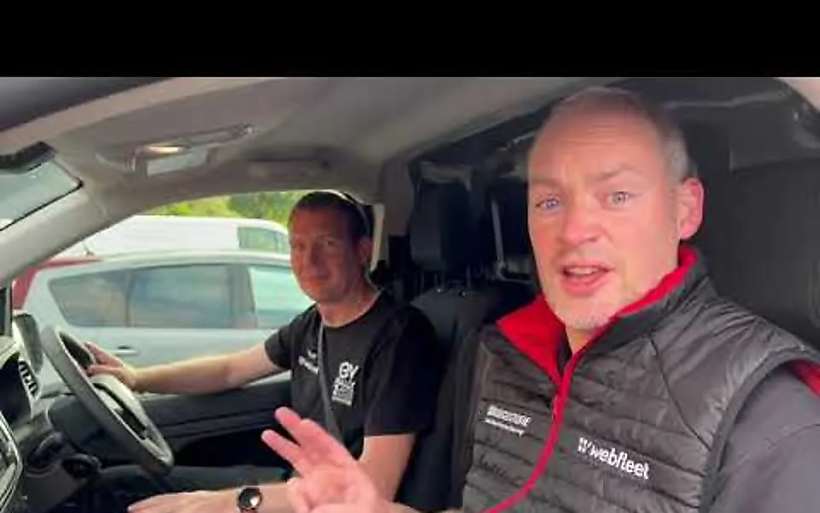As a recent five times Guinness World Record holder, Kevin Booker specialises in maximising electric vehicle range through long-distance trips in both electric cars and vans. This article will delve into most recent record achievement and then offer six invaluable electric car driving tips to maximise your EV efficiency.
6 electric car driving tips:
1. Read the road ahead
Revert to your driving lessons where your driving instructor told you to read the road ahead and adjust accordingly. This is no different when driving an electric car. However, over time, people tend to switch off when driving, which results in late braking, heavy acceleration and erratic driving when faced with an obstacle.

Reading the road ahead and anticipating traffic light changes, gaps at roundabouts and change in directions will make your driving experience smoother and drastically improve the efficiency of your electric car or van. Over time, adjusting your driving style will allow you to gain plenty of additional miles to ensure you reach your destination.
Telematics systems such as Webfleet can help with route optimisation to ensure you can focus on the road.
2. Select the right tyres
Like with any vehicle, tyres are what connect you to the road. When searching for a new set of tyres, one may consider a premium-rated tyre for increased safety or more fuel efficiency. This is still the case with EVs. In fact, tyre choice is even more important as this will have a direct impact on your battery range. Therefore, when shopping for tyres for your fleet or personal use, I would recommend selecting an A-rated tyre for rolling resistance. Over time, the right tyres will result in reduced charging frequency and provide you with additional battery range for your peace of mind.
Furthermore, these tyres can boost the specified range of electric cars by curbing energy consumption. One such example is the Bridgestone TURANZA EV. It is designed to help maintain a long mileage range per charge without sacrificing tread life by extending energy-efficient performance with low rolling resistance.
3. Take advantage of regenerative braking
A key difference when switching to EVs is utilising kinetic energy via regenerative braking. As you lift your foot off the accelerator the car begins to decelerate at a much quicker rate. The kinetic energy that is usually wasted is replenished back into the battery during deceleration and turns into electrical power. Therefore, by adjusting your driving style to lift off the pedal earlier before junctions, the regenerative braking will do most of the work for you.
Mastering regenerative braking allows you to reduce the excessive use of your brake pedal and increase battery range. In the long run, utilising this technique will increase the life of your brake pads, reducing one of the very few maintenance costs of running electric vehicles.

4. Check your tyre pressures
Selecting the correct tyre is just the first step to maximising your electric car or van range. Without the correct tyre pressure, the tyres will be less stiff resulting in a higher rolling resistance and decreased range performance. Therefore, if you have chosen an A-rated tyre for rolling resistance, you will not be maximising the efficiency potential.
Research indicates that a slight reduction in PSI can significantly impact the battery range of both electric cars and vans. To maximise tyre performance, I strongly recommend checking your tyre pressures at least once a month and before and after long-distance journeys.
5. Reduce the heaviness of your right foot
Acceleration: New electric cars offer instant power, enabling quick manoeuvring at junctions and during overtakes. However, it’s important to note that aggressive acceleration negatively affects your overall electric range. To ensure a smoother and more efficient journey, it is advisable to train yourself to gently press the accelerator, gradually increasing momentum to reach your desired speed. This driving approach not only enhances your real-world battery range but also extends the lifespan of your tyres.

6. Plan your electric car or van load
Whether you’re a delivery driver with fixed stops or planning a family holiday, factoring in added vehicle weight is crucial. Often overlooked is how additional loads can impact the battery range along the journey. Therefore, it’s advisable to travel with minimal weight, avoiding unnecessary cargo whenever possible. While certain payloads may be unavoidable, consider the effect on the vehicle’s range and adjust accordingly. If possible, you can make an additional stop at a charging station or wait to charge a few extra percentage points on the battery. These measures will ultimately help you operate your electric car or van more efficiently and save time in the long run.
EV Rally 2023 – The ultimate electric vehicle driving test
Recently, I completed a 1,200-mile trip across the UK and Ireland as part of the EV Rally 2023. I joined Team Webfleet, driving their Vauxhall e-Vivaro, which had a 68Kwh battery. A battery of this size provides over 200 miles per charge and peak charging speeds of over 100kW. Throughout the journey, we tested the WLTP figures and UK charging infrastructure, confirming that the e-Vivaro was more than capable of covering the distance. Additionally, we compared the infrastructure in major cities like Cardiff, London, Belfast, and Dublin.
In terms of efficiency, day two was by far our most successful day as we achieved 3.6MpkWh! Our efficient driving led to an impressive 244 miles of battery range on a single charge. This coincidently was also the day where, at one of the checkpoints, we achieved a peak charging speed of 92kW!

The rally showcased the remarkable progress of the UK EV charging infrastructure over the last five years. Not to also forget, how much battery range has developed in electric cars and vans over the past few years. This demonstrates that EVs are here to stay. Electric cars and vans are becoming more accessible and practical for the masses, which is a testament to the collaboration of businesses supporting its adoption. Insights into EVs provided by Webfleet EV telematics highlighted how managing an EV fleet can be made easy.
Are you looking for the right telematics partner to support your electric vehicles? Webfleet electric vehicle fleet management software gives you the tools you need to manage your EVs. Optimise charge cycles to lower costs, increase productivity and achieve a better return on investment (ROI). Discover more about electric vehicle solutions by booking a call with Webfleet EV experts for free.








